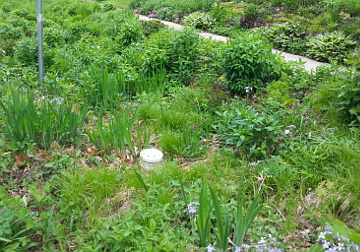Rain gardens: a beautiful way to reduce runoff pollution!
Rain gardens, which are small, shallow areas filled with beautiful native plants, reduce polluted runoff from entering Wisconsin’s waters. Creating a rain garden is a great way for homeowners, schools, businesses, churches, and other organizations to help protect our lakes and streams. Rain garden plants capture 30% more water than a regular lawn and filter that water into the ground. This reduces the amount of water containing household fertilizers, pesticides, oils, and other contaminants coming from our roofs, lawns, driveways, or parking lots running into storm sewers. Rain gardens are also a delight to view and are a nice place for birds and butterflies to live.
The Wisconsin Department of Natural Resources invites you to help clean up our waters by building your own rain garden!
- Rain gardens: a guide for homeowners and landscapers (high-quality publishing version)
- Rain gardens: a guide for homeowners and landscapers (smaller filesize print version)
- How to build a rain garden [exit DNR]

